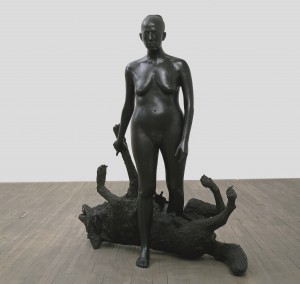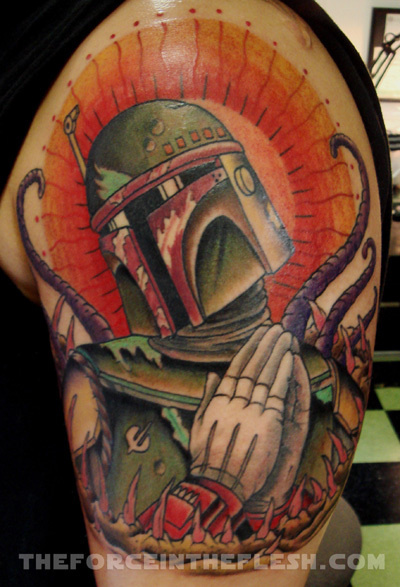Jonathan Lethem brings us issue 7 of THE THING, a quarterly in object form in which invited artists, writers, etc. create/curate an issue.
Lots of recent activity at the Underground Library, mostly thanks to Dave Clapper and Ellentparker. Feel free to build from what they’ve done or add a new entry. Madore wants significantly to expand the database by the end of 2010.
Fuck
Seems like people like to edit things down to what offends them a lot of the time. Positive efforts get sometimes burped.
Here’s where somebody did that with the movie Casino, but in a fun way.
It’s okay to have fun.
In-ter-net.
Kiki Smith
 I feel cross-influenced. By that I mean that some visual artists and musicians have as much influence on my writing as writers do, often more. For this reason I want to show you some pictures of work by Kiki Smith, a visual artist who makes incredible objects.
I feel cross-influenced. By that I mean that some visual artists and musicians have as much influence on my writing as writers do, often more. For this reason I want to show you some pictures of work by Kiki Smith, a visual artist who makes incredible objects.
I realize that a lot of HTMLgiant readers might feel like the art world is another planet. It often feels that way if you go to an art gallery opening to mooch free wine or the MoMa on a busy afternoon. Maybe you were stoned all the way through your Art History 101 class in high school or college or maybe you never took one or maybe your teacher was unforgivably snobbish. Maybe it seems like 90% of the “contemporary art” you’ve seen shouldn’t be called art at all. That might be true. I don’t know. I just know there are a lot of living artists that I love because I get that giddy-faced-piss-my-pants feeling when I see their work in real life. Kiki Smith is probably at the top of this list of Artists Who Are Like Writers.
I feel like writers and visual artists have a lot more in common than we often acknowledge. Writing and making objects are lonely endeavors. We’re both trying to get something that is so clear in our brains to be just as clear to other people. READ MORE >
Ani Smith interviews HTMLGIANT contributor Mike Young for Writers’ Bloc. Contains awesome original song.
15 Significant Contemporary Women Writers
Blake’s recent post on Towering Literary Figures inspired me to consider a list of significant contemporary (living) women writers. By significant I mean significant to me: women writers who I admire and who I feel have significantly contributed to the advancement of literature.
Perhaps someone else on the Giant staff will take up this theme and focus on writers of color, or GLBT writers, or writers from Australia, or writers with children, or writers still living with their mothers, or etc.
For the record, I understand that what I am doing here is, to a degree, essentialist: by labeling a writer based on their gender I am furthering a world in which these distinctions exist. Furthermore, I completely sympathize with the position that argues that we should not see color or sex or race or whatever, that we should instead see only writers.
But, alas, differences exist.
So, with my disclaimer now fully realized, I give you my list of contemporary women writers that I think kick a lot of ass –(in black&white and in no particular order):
The subconscious syntax of Michæl Chabon’s hair
Michæl Chabon can’t keep it up — that wisp of hair that seems to always hang on his forehead all the time. At first glance, one sees a random tuft from a man perhaps too deep in thought to use a comb more than once a day; but I started noticing that these locks made grammatical marks, as if to suggest “don’t just read my book, read my face.” I once went to a Chabon reading at the public library. He called the organizers from his cell phone minutes before the event claiming public transit was crazy. “More fountain water for me,” I thought.
The following is a list of the subconscious syntax of Michæl Chabon’s hair, including excerpts which illustrate said grammatical functions.
1. The Apostrophe

Chabon is not in the business of the avante garde, so there will be no mind blowing today, just a pretty legit use of apostrophes. From The Amazing Adventures of Kavelier & Clay, which won the Pulitzer in 2001:
As soon as the German army occupied Prague, talk began, in certain quarters, of sending the city’s famous Golem, Rabbi Loew’s miraculous automaton, into the safety of exile.
That was a pretty nice use of two apostrophes, both as possessive ones. I tried to find apostrophes used as contractions, but couldn’t, so I’ll put some of my own. I have a feeling maybe good writers aren’t supposed to use contractions. Ain’t that shit.
Brief q+a with Laird Hunt (updated with comments re: Ulysses thread)
 I’ve read some good books put out by good presses this year (Graywolf, Dalkey and the NYRB come to mind, but I’m not discounting Eugene Lim and Ellipsis’s [Ellipses?] forthcoming books from that list. Can’t wait to check those out). But I don’t think anyone has hit it out of the park yet in 2009 like Coffee House. Evenson’s book completely eviscerated me and others just like me and probably others not at all like me (it has that kind of broad appeal). It’s easily the best story collection I’ve read in quite awhile. The other beauty, though, is Ray of the Star by Laird Hunt. The story of a guy named Harry, shattered by an accident that took the lives of his family, as he attempts to reconnect to life, love and sanity kicks serious ass. Remarkably, Hunt just keeps getting better, and it excites me to think that we haven’t even seen his best yet. I emailed with the author a little bit, and he fielded my asinine questions, which I just sent to him en masse, with wit and aplomb.
I’ve read some good books put out by good presses this year (Graywolf, Dalkey and the NYRB come to mind, but I’m not discounting Eugene Lim and Ellipsis’s [Ellipses?] forthcoming books from that list. Can’t wait to check those out). But I don’t think anyone has hit it out of the park yet in 2009 like Coffee House. Evenson’s book completely eviscerated me and others just like me and probably others not at all like me (it has that kind of broad appeal). It’s easily the best story collection I’ve read in quite awhile. The other beauty, though, is Ray of the Star by Laird Hunt. The story of a guy named Harry, shattered by an accident that took the lives of his family, as he attempts to reconnect to life, love and sanity kicks serious ass. Remarkably, Hunt just keeps getting better, and it excites me to think that we haven’t even seen his best yet. I emailed with the author a little bit, and he fielded my asinine questions, which I just sent to him en masse, with wit and aplomb.
I was reading your playlist suggestions on the Times website, and I was pretty blown away to read that you wrote Ray of the Star in six weeks. Do you normally write that fast? You strike me as more of a deliberate writer, agonizing over word placement and rhythm and other aesthetic concerns. Six weeks!?
I’ve never written anything that fast, although years ago I wrote the first draft of my first book, The Paris Stories, with considerable speed (and a lot of cigarettes). Of course there was a good deal of reworking, after I had done the first draft of Ray, but it was nothing like my experience with the first three novels, each of which unfurled themselves slowly over a period of years. Both Indiana, Indiana and The Exquisite lived happy plot-free existences for at least 2 or 3 years before I saw the stories in them and could start to think of ways to shape those stories into something interesting. Ray’s story and the plot built in and around it were there from the beginning. As were those bloody sentences.
Chris Tonelli on Ellen Kennedy, at Open Letters Monthly
 After the epic fail that was Matt Soucy’s lazy, mean-spirited review in Coldfront–a rare blunder for one of the best poetry sites out there–it brings me enormous pleasure to direct your attention to Chris Tonelli’s excellent microreview of sometimes my heart pushes my ribs, newly online at Open Letters Monthly.
After the epic fail that was Matt Soucy’s lazy, mean-spirited review in Coldfront–a rare blunder for one of the best poetry sites out there–it brings me enormous pleasure to direct your attention to Chris Tonelli’s excellent microreview of sometimes my heart pushes my ribs, newly online at Open Letters Monthly.
May the Force Be With You When You’re Burning in Hell

You’ve just got to check out this gallery of Star Wars religious art, over at io9.


